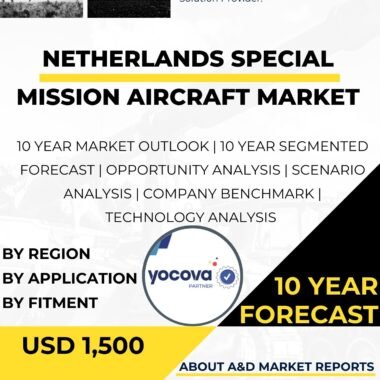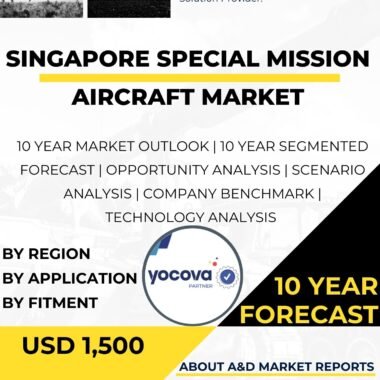Description
The special mission aircraft market in Japan has seen significant growth and strategic importance as the nation seeks to enhance its intelligence, surveillance, reconnaissance (ISR), and search and rescue capabilities. Special mission aircraft are customized platforms equipped with advanced sensors, communication systems, and mission-specific equipment to perform specialized tasks, such as aerial reconnaissance, maritime patrol, electronic warfare, and airborne surveillance. These aircraft play a crucial role in modernizing Japan’s defense and security forces, enabling them to gather critical information, respond to emergencies, and safeguard national interests.
The special mission aircraft market in Japan encompasses a diverse range of aircraft, including modified commercial platforms, business jets, and military aircraft configured for specific missions. These aircraft are used by various agencies, including the Japan Self-Defense Forces (JSDF), Japan Coast Guard, Japan Maritime Self-Defense Force (JMSDF), and Japan Air Self-Defense Force (JASDF), providing Japan with a comprehensive special mission aircraft capability across different sectors.
One of the primary applications of special mission aircraft in Japan is in enhancing its intelligence, surveillance, and reconnaissance capabilities. Special mission aircraft equipped with advanced sensors, electro-optical cameras, synthetic aperture radar, and signals intelligence (SIGINT) systems enable Japan to collect real-time intelligence and monitor activities in its airspace and maritime domain. These aircraft support the nation’s efforts in monitoring potential security threats, safeguarding territorial waters, and maintaining situational awareness in regional areas of interest.
Moreover, special mission aircraft play a crucial role in maritime patrol and search and rescue operations. Japan’s extensive coastline and vast maritime territory require robust surveillance and response capabilities to protect its waters, safeguard its fishing interests, and respond to maritime emergencies. Special mission aircraft, such as maritime patrol aircraft and search and rescue helicopters, enable the swift detection of vessels and aircraft in distress, enhancing Japan’s maritime security and ensuring timely rescue operations.
Furthermore, special mission aircraft contribute significantly to Japan’s electronic warfare capabilities. Aircraft equipped with electronic warfare systems can gather signals intelligence, intercept and jam enemy communications, and support information warfare operations. These capabilities are essential for enhancing Japan’s electronic warfare readiness and countering potential electronic threats in contested environments.
As Japan emphasizes indigenous defense capabilities, the domestic production and modification of special mission aircraft have seen substantial growth. Collaborations between the government, defense industry, and research institutions have fostered innovation, leading to the creation of specialized aircraft tailored to Japan’s specific defense and security requirements.
Japan’s alliance with the United States has also played a significant role in the development of its special mission aircraft capabilities. Through this partnership, Japan has access to advanced special mission technologies, expertise, and support, contributing to the modernization of its defense and security forces and enhancing interoperability with allied nations.
The special mission aircraft market in Japan also benefits from advancements in sensor technology, data processing, and avionics. Manufacturers have leveraged these developments to equip special mission aircraft with state-of-the-art sensors, data fusion capabilities, and enhanced avionics, making them more effective and adaptable to evolving security challenges.
However, the special mission aircraft market in Japan also faces challenges related to cost, obsolescence, and airspace management. Specialized mission systems and equipment can be costly to procure and maintain, requiring significant investment in research, development, and sustainment.
Addressing obsolescence in special mission aircraft is crucial for ensuring that these platforms remain technologically relevant and capable of meeting evolving mission requirements. Upgrading and modernizing specialized equipment and avionics are essential to extend the service life and enhance the capabilities of existing aircraft.
Moreover, airspace management is critical for coordinating the operations of special mission aircraft with other military and civilian aircraft in crowded airspace. Ensuring safe and efficient integration of these aircraft requires effective coordination and airspace surveillance.
In conclusion, the special mission aircraft market in Japan has witnessed significant growth and strategic importance, driven by the nation’s focus on enhancing its intelligence, surveillance, reconnaissance, and search and rescue capabilities. Special mission aircraft provide critical solutions for aerial reconnaissance, maritime patrol, electronic warfare, and search and rescue operations, catering to various sectors and user needs. The collaboration between the government, defense industry, and research institutions, as well as international partnerships with allied nations, fosters innovation and contributes to the growth of the domestic special mission aircraft market. Addressing challenges related to cost, obsolescence, and airspace management is crucial for further enhancing Japan’s special mission aircraft capabilities and ensuring that its defense and security forces remain equipped with advanced and reliable platforms to effectively respond to security threats, safeguard national interests, and contribute to regional and global security efforts. With its strategic focus on indigenous defense capabilities, Japan remains committed to leveraging advanced special mission aircraft technologies to enhance its ISR capabilities, conduct maritime patrol and search and rescue operations, and address evolving security challenges effectively.




